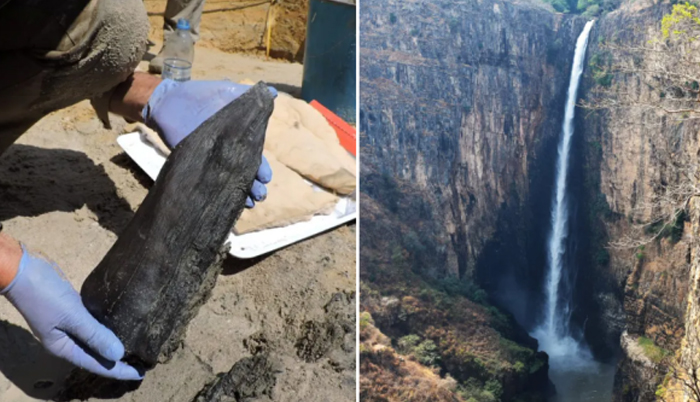![]() Home > Its A Funny World
Home > Its A Funny World
Ancient Pieces Of Wood Prove Our Ancestors Were Smarter Than We Thought

A wooden structure above a waterfall has changed our thinking of the Stone Age (Picture: Professor Larry Barham/UOL/SWNS)
![]() May 13th, 2024 | 02:33 AM |
May 13th, 2024 | 02:33 AM | ![]() 574 views
574 views
METRO
The world’s oldest man-made wooden structures dating back to the Early Stone Age have been found in Africa – suggesting our ancestors were far more advanced than previously believed.
It is the earliest evidence from anywhere in the world of the deliberate crafting of logs to fit together – and much earlier than previously thought possible.
A research team from the University of Liverpool and Aberystwyth University analysed the well-preserved wood at the archaeological site of Kalambo Falls in Zambia. It dates back at least 476,000 years, before Homo sapiens – modern humans – had appeared.
Expert analysis of stone tool cut-marks on the wood show that early humans shaped and joined two large logs to make a structure, probably the foundation of a platform or part of a dwelling.
Until now, evidence for the human use of wood around this time was limited to making fire, digging sticks and spears.
The research team said wood is rarely found at such ancient sites as it usually rots and disappears, but Kalambo Falls’ permanently high water levels preserved it.
The discovery, reported in the journal Nature, challenges the prevailing view that Stone Age humans were nomadic.
The research team explained that at Kalambo Falls human ancestors not only had a perennial source of water, but the forest around them provided enough food to enable them to settle and make structures.
This study forms part of the pioneering ‘Deep Roots of Humanity’ project, an investigation into how human technology developed in the Stone Age.
Liverpool University professor Larry Barham, who leads the ‘Deep Roots of Humanity’ project, said: ‘This find has changed how I think about our early ancestors.
‘Forget the label “Stone Age”, look at what these people were doing – they made something new, and large, from wood.
‘They used their intelligence, imagination, and skills to create something they’d never seen before, something that had never previously existed.
‘They transformed their surroundings to make life easier, even if it was only by making a platform to sit on by the river to do their daily chores.
‘These folks were more like us than we thought.’
The specialist dating of the finds was undertaken by Aberystwyth University scientists.
They used state of the art luminescence dating techniques, which reveal the last time minerals in the sand surrounding the finds were exposed to sunlight, to determine their age.
‘At this great age, putting a date on finds is very challenging and we used luminescence dating to do this,’ said Professor Geoff Duller, from Aberystwyth University.
‘These new dating methods have far reaching implications – allowing us to date much further back in time, to piece together sites that give us a glimpse into human evolution.
‘The site at Kalambo Falls had been excavated back in the 1960s when similar pieces of wood were recovered, but they were unable to date them, so the true significance of the site was unclear until now.’
The site of Kalambo Falls on the Kalambo River lies above a 235 metre waterfall on the border between Zambia and Tanzania, on the edge of Lake Tanganyika.
The area is on a ‘tentative‘ list from UNESCO for becoming a World Heritage site because of its archaeological significance.
‘Our research proves that this site is much older than previously thought, so its archaeological significance is now even greater,’ said Professor Duller said.
‘It adds more weight to the argument that it should be a United Nations World Heritage Site.’
Professor Barham added: ‘Kalambo Falls is an extraordinary site and a major heritage asset for Zambia.
‘The Deep Roots team is looking forward to more exciting discoveries emerging from its waterlogged sands.’
Source:
courtesy of METRO
by Stephen Beech
If you have any stories or news that you would like to share with the global online community, please feel free to share it with us by contacting us directly at [email protected]